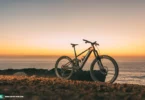The E-MOUNTAINBIKE City Escape is a series of international guides created in collaboration with Haibike. The aim is to inspire a new generation of riders to embark on a different sort of lifestyle – one with new perspectives and full of possibilities. The City Escapes throw back the curtain on exciting ways to experience cities across the globe, whether you’re a tourist or a long-time resident.

Each E-MOUNTAINBIKE City Escape Guide dishes out inspiration in its own unique way. Get to know a new side of global cities, meet interesting locals, and pick up the best insider tips, such as the local lingo, the dos and don’ts, as well as the must-visit cafes, bars, restaurants, and bike shops. Naturally, GPX files of selected routes are included. In each City Escape feature, we also present the bikes that we used for exploring the city and its surroundings.
Dive into the following 6 chapters:
- 1/6 Berlin Calling – So Berlin
- 2/6 Checking it out – Tour mode > Tourist bus
- 3/6 What’s going on? How to spend time in Berlin
- 4/6 Riding in Berlin – Where to go on two wheels
- 5/6 Fuelling & co. – Cafés, bars, restaurants, the dos & don’ts of Berlin
- 6/6 Escape faster – Our electric whips in detail
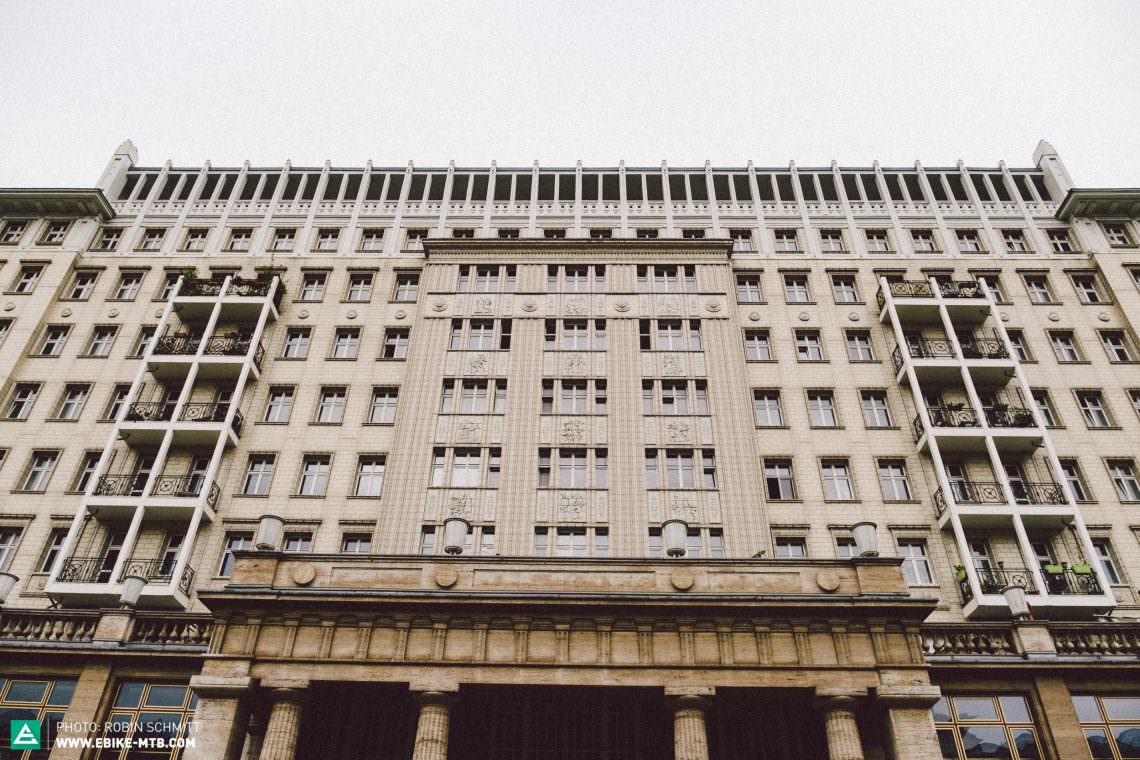
1/6 Berlin Calling – So Berlin
Lisbon has sunsets, Paris has the Eiffel Tower, but what about Berlin? Easy. Its underground scene, the creative community, the music. It’s time to make our way into another world where parties are held underneath manhole covers and thumping techno resonates to discover what makes this controversial city tick. Art and culture, 4X to cuisine, are you ready for an assault on the senses?



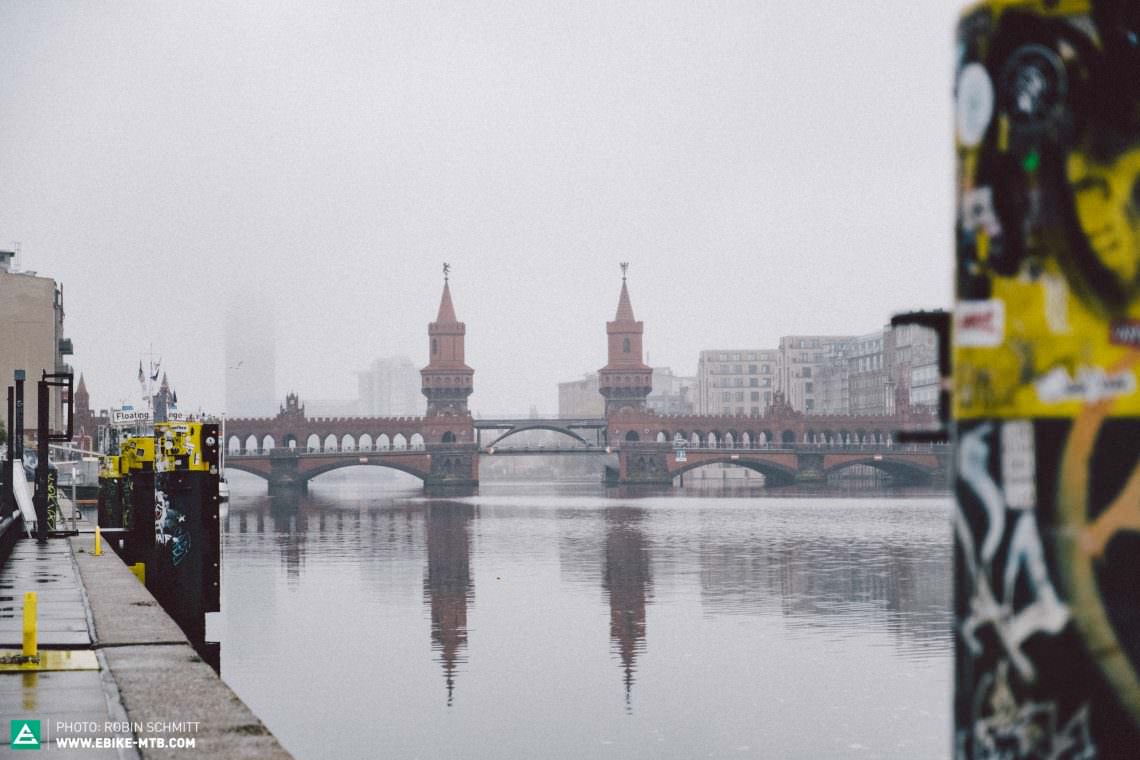
If grimy and in-your-face, debauched and a little dirty don’t do it for it, try political, cultural, diverse and a hotbed of start-ups and creatives. You choose. Labelling it as one thing is almost impossible. Some people make do with an annual pilgrimage to satiate the curiosity. Others consider Berlin overhyped, somewhere to steer clear of. And then there are those who assemble here for its open-mindedness, the outlandishness and the way it lends itself to a more alternative lifestyle.
A pretty young city in the grand scheme of things, Berlin had a rough time growing up. Surrounded by swamps (hence its name, which traces back to the ancient Slavic word for marshland), the current German capital endured its fair share of tumultuousness, pitching glorious highs next to bitter lows on repeat. You don’t have to go far back in time to see just how turbulent the city’s trajectory has been – take the rollercoaster of the 1900s, for example. Few cities have such a dramatic backstory as Berlin, which was perpetually on the frontline of massive, gut-wrenching events: subjected to plague upon plague during in the 16th century when it was the royal seat, followed by the Thirty Years’ War in the 1600s, Napoleon’s occupation in the 18th century, the industrial revolution, and then the First World War, which left its citizens hungry and in dire need of support.
Things took a turn for the better in the golden twenties, as Berlin became the place to be, especially those looking for excess and excitement. For many global icons, the backdrop of art, drugs, politics, freedom, emancipation, and extremism was the stage to launch a career.

It was the milieu of the creatives, even then. Cabaret, ballrooms, glamour: it was the place where Brecht penned his Threepenny Opera and Josephine Baker found fame with her seductive barely-there banana-skirt dance and ostrich-led cart in front of the Hotel Adlon. Painter Otto Dix didn’t just immortalize the intoxicating decadence of the time in his renowned triptych of the city, he illustrated an icon that embodied the era like no one else: Anita Berber. The quick-witted femme fatale of the epoch, Anita Berber wore a face of heavy, pale makeup as she danced nude, with scandal after scandal in her wake. Posing unclothed for Dix, he painted her as he saw her: a vamp in a red dress, a face etched with lines that far exceeded the young age on her death certificate. It was a commentary on her lifestyle, one that alongside copious amounts of cocaine and cognac, allegedly included rose petals soaked in chloroform for breakfast. The excesses of Berlin’s beloved idiosyncratic night-dweller led to her death in 1928.

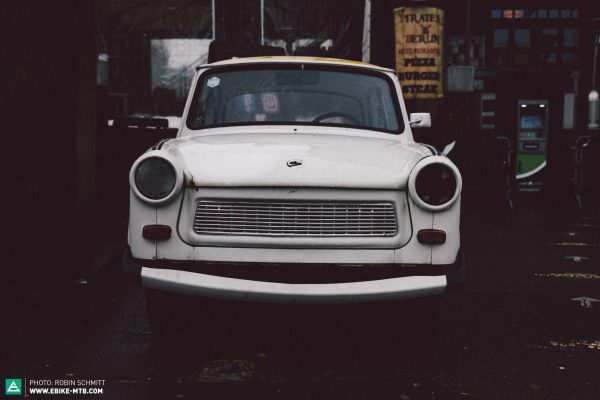
Not long after her demise, the city suffered a similar fate. Many factors collided, including the Wall Street Crash, which left a gap for the fascist National Socialist Party to step in and plan their domination. The Second World War came as a consequence, sparking more conflict and ending in four occupied zones, which later became two that were unceremoniously split by an imposing wall, the passive front between two ideologies. Tough times. Since reunification in 1989, Berlin has continued to spew out into two camps: east and west, left and right, new and old, past and future, poor and rich, modest and trashy, techno and punk, Neukölln and Prenzlauer Berg, day and night.


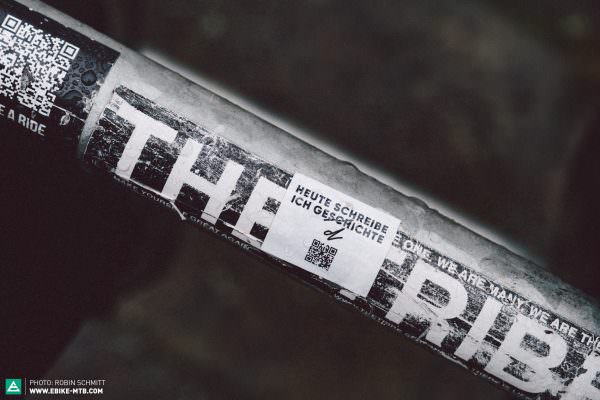

The foundations of this global city are basically built on contrasts and divisions–physical and metaphorical. Where previously there was a wall that split the city into East and West, today’s Berlin is a sea of bridges, leading an unmistakable identity to course through it. It projects an image of freedom with tolerance and solidarity held up as bastions of its character. Almost every second Berliner comes from elsewhere, with more than 40% of the 3.7 million residents heralding from outside of Germany. The city has an unwritten rule: ‘Be who you are, love who you want.’ Not adhering to gender norms, you could say, is actively encouraged. Each year, more than a million people descend onto the streets to celebrate Christopher Street Day.

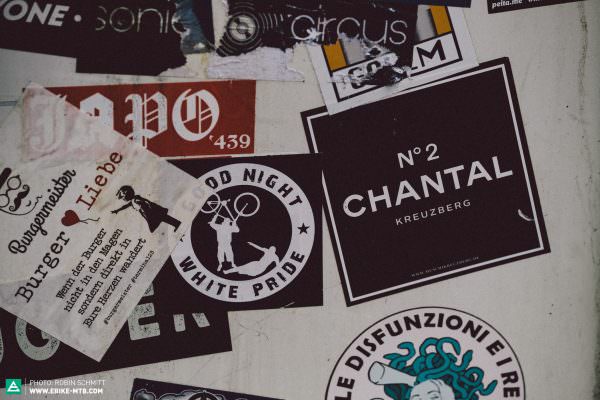


As a stage for political and cultural discourse, the city on the banks of the River Spree often sets the tone for the whole country. It faces its past head-on, without trying to deny it: Turn a corner and you’ll find another story, a pressing topic, or a trend, with monuments that command your attention. ‘Stolperstein’ cobbles often, quite literally, stop you in your tracks and prompt you to reflect, while thought-provoking graffiti makes a standpoint in favour of squats or protests. It’s labyrinthine, propelling you through the past, present and future of the city. And fortunately, despite all its moral hang-ups, it doesn’t take itself too seriously – see how it deals with too-short train platforms, chaotic builds for the new airport, and the unofficial ‘Arm aber sexy’ (Poor, but sexy) slogan. In a way, it’s still trying to be as laissez-faire as the Huguenots, who arrived from pre-revolution France.


Labelled as the creative capital, you find a veritable who’s who of brands, agencies, start-ups and artists here. With hip typography on witty posters, achingly cool hotels, boutiques and cafes in every direction, there’s a sense of being in Germany’s creative nerve centre. The rawness of the city attracts entrepreneurs and creatives are attracted in equal measures, like moths to a light or technoheads to Berghain. Door-knocking for exclusive entry, Berlin’s creative circles are as elite as its clubbing scene. Entry requires you giving something back – a metaphorical cake, or something. Collaborations are commonplace.
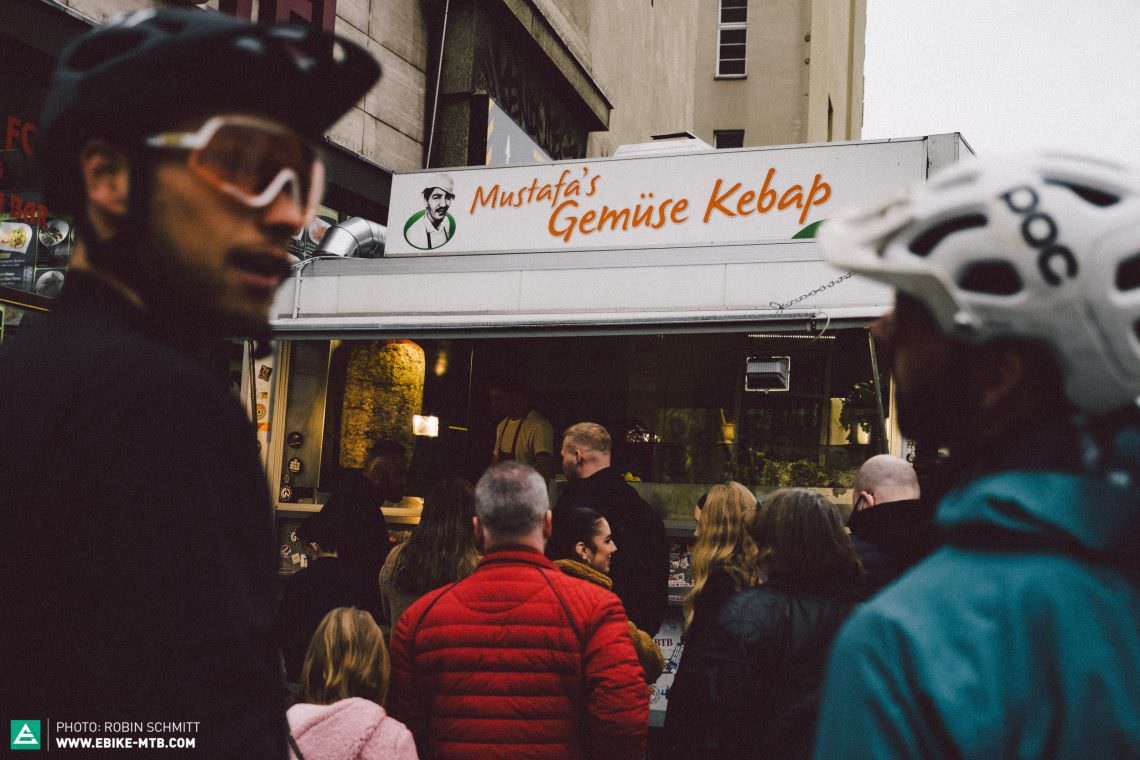
As a city, it never stands still. And no one wants it to. That’s not why they are here. With not just Germans flocking to the city, but immigrants of all ethnicities from across the globe, it lends itself to a very special dynamic, unmatched virtually anywhere else. The hotchpotch of lifestyles, attitudes, dreams and tastes merge, generating a cultural melange that influences the city and its inhabitants on a daily basis. They grow and develop as one, creating a totally unique society, perceptible in the sights, sounds and taste of every single neighbourhood.
Like for so many, Berlin is the alternative to our daily lives. Or rather, it’s the city of alternatives, one where you don’t have to fall in line, and you can dance to your own tune. But now subjected to covid-19 lockdowns and closures, how’s the city faring? Pull down your beanie, roll up your chinos and let’s take our Haibikes into Berlin. Masks and helmets obligatory.



2/6 Checking out Berlin – Tour mode > Tourist bus
It’s still dark outside and even the weather forecasters are hesitant to over-promise. Heavy gray clouds keep the temperature below 7°C, regularly dousing everything in fat droplets. Berlin in November, herzlich willkommen.
European cities in the rain rarely look their best. We opt for another oat milk flat white as Berlin’s rush-hour traffic passes by the window. Knowing that the City Escape will have to happen today, we work up the courage to unplug our bikes and get going.


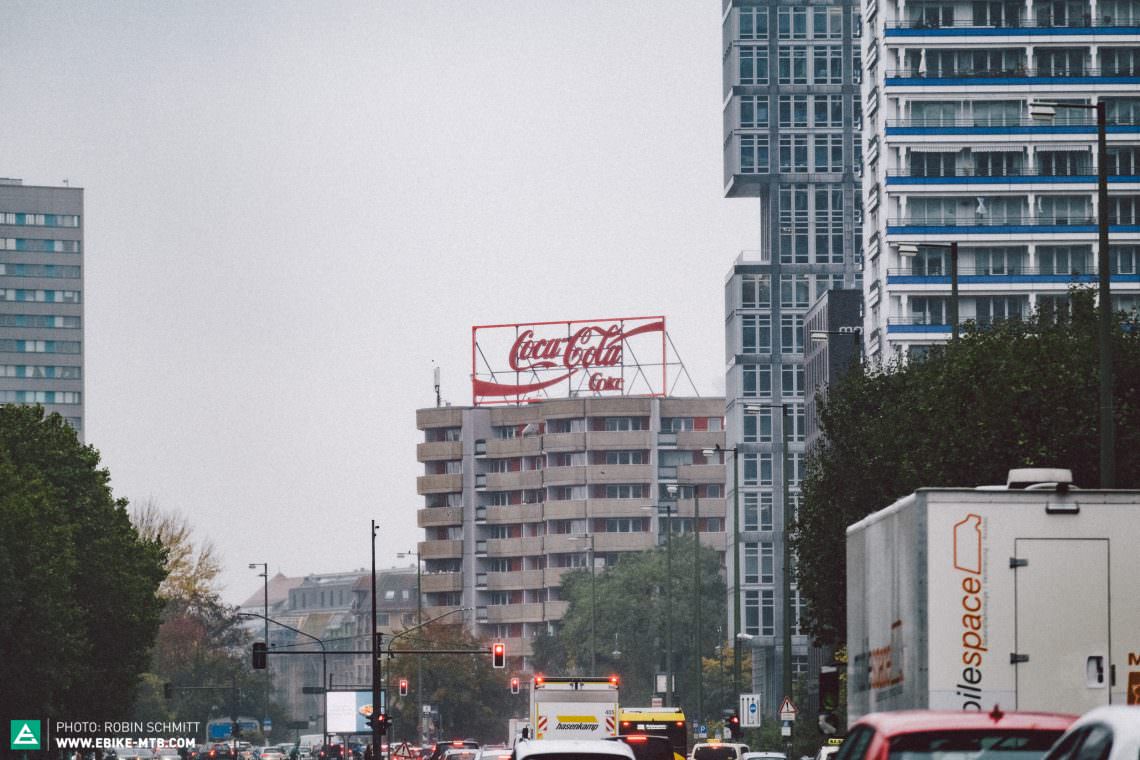
We’re joined by Isabel, a Berliner-by-choice and entrepreneur working in the digital space, who fortunately isn’t averse to a bit of sightseeing in her free time. Thanks to Corona, Berlin is notably quiet these days – the monthly figures of a million tourists have unsurprisingly dwindled. It’s a good time for the city’s own residents to take up the mantel, even if the weather is against the idea. Isabel, ‘Isi’ for short, is, however, unfazed, pulling on a rain jacket and nodding wordlessly at the door. We pull on oru Airbag helmets from Hövding and prepare our Haibike SDUROs. The neighbourhood of Friedrichshain is where we’ll start and end our ride. The wind pushes us along the River Spree towards Mitte, passing the longest remaining section of the Berlin Wall, now famed for being the East Side Gallery, the world’s biggest open air art gallery.


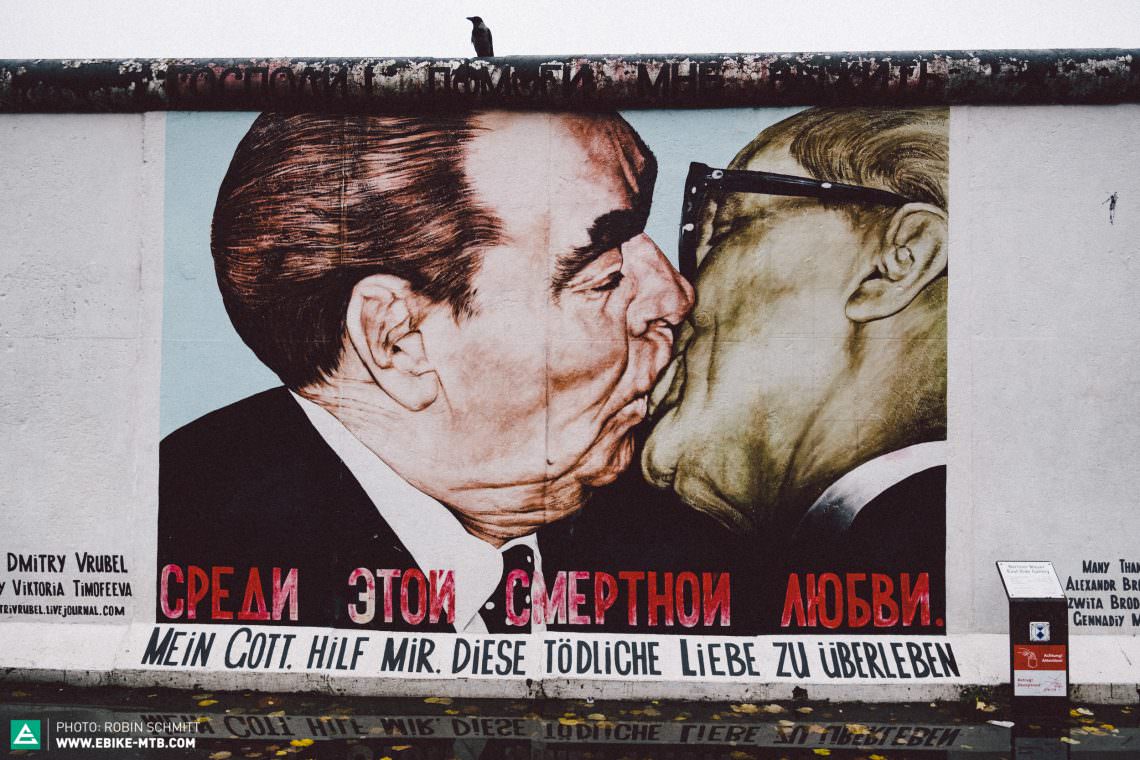
Free entry: After the wall fell in 1989, 118 artists from 21 countries used this 1.3 km-long stretch of wall as a canvas to commentate on the political upheaval. Most of the artworks were re-done in 2009, and in the two-plus decades since reunification there’s been no shortage of controversy over building plans in this very spot. But those aside, the wall with its iconic depiction of a brotherly socialist kiss between Honecker and Breschnew remains a symbol for how the city and country overcame the division. It’s also one of the city’s most visited relics of history, a stark reminder of the inhumanity of the border put up by the German Democratic Republic.




The city’s most beautiful bridge is now behind us: the Oberbaumbrücke. Once a simple wooden dam where boats paid their custom duties, this double-decker neogothic bridge with its striking towers is another symbol of German reunification, marking the boundaries between the trendy neighbourhoods of Friedrichshain and Kreuzberg. Bars, clubs, cafes and restaurants have popped up and it’s one of those places where the night only has to end on occasion. In non-corona times, you’d still hear thumping bass as families dropped their kids off at kindergarten from their cargo bikes. Today, it’s a bit more muted.




We keep riding towards a flashier side of Berlin, but not before Borat with a strategically positioned face mask flickers by on our left. Those contrasts we mentioned earlier keep coming. We pedal out of the past towards the future, into a neighbourhood of new builds, where sleek residential and commercial properties line the pavements. It’s very different in Mitte, where more than 80% of the residents originate from outside Berlin. Some cry gentrification as the flat white city slickers attempt to spread out their influence beyond this neighbourhood’s boundaries. For many of the so-called pioneers, treasure hunters, content creators and media savvy pros, Berlin Mitte is their canvas to rebuild in their vision – out with the furniture, no more carpets, peel back the wallpaper; exposed brickwork and wooden floors only. Berlin’s rebellious side is notably absent here these days, replaced by G-wagons, boutiques, bakeries and franchises. But in a way, this is still Berlin through-and-through – that sense of reinvention but still somehow opposed to the norm. Even in this area, you can tell it is a city that thrives on the Currywurst-Champagne tug-of-war.


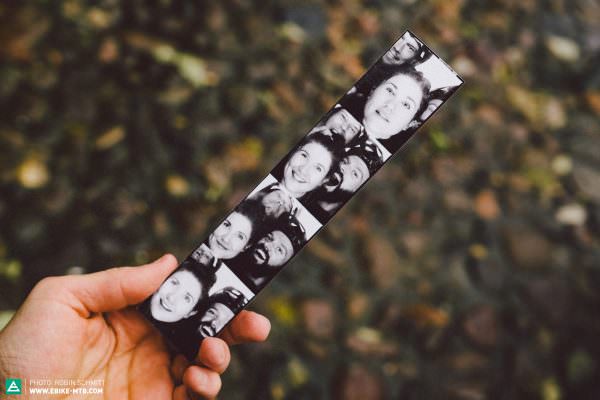


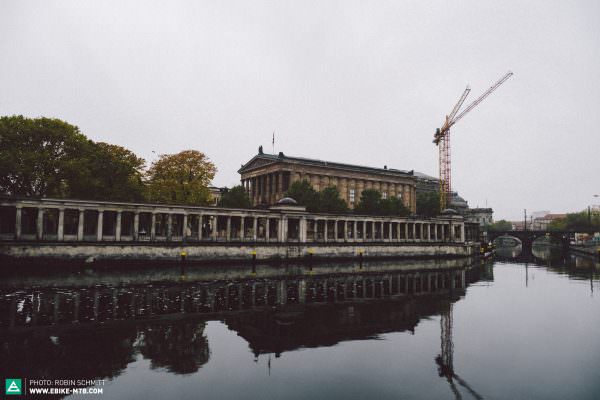
Hunger spurs us into boost mode, snaking our way across Museuminsel, the UNESCO World Heritage Site that’s home to five of Europe’s most significant museum complexes. Nearby the Fernsehturm TV tower – another symbol of gentrification – we brake, pulling up for another coffee, vegan apple strudel and chance to dry off our jackets. The baker impresses us and we order another round, reluctantly admitting that the weather forecasters were right – ‘the drop won’t stop’. If it wasn’t for the Yamaha motors on our Haibikes, we’d probably still be in the bakery.
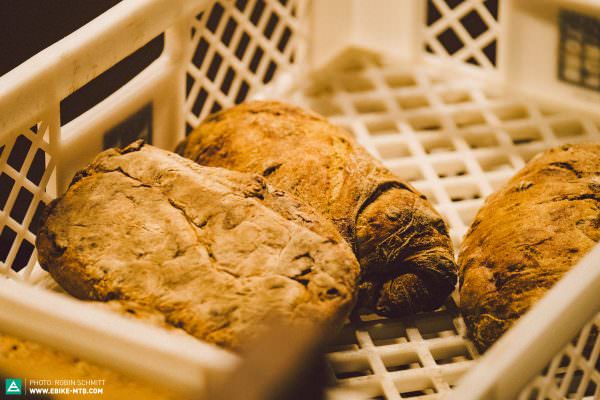
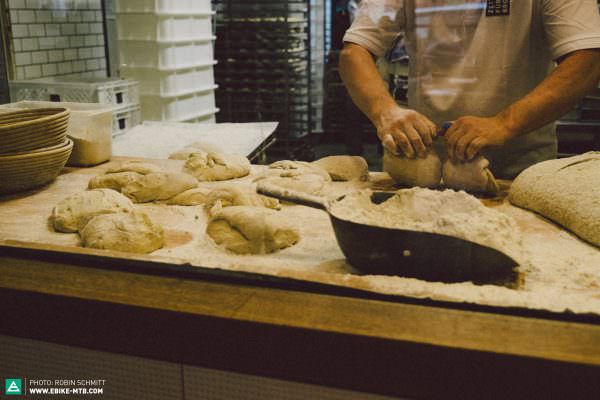
A pop-up bike path heading east escorts us along Frankfurter Allee, an impressive boulevard lined with what were the most sought-after properties you could get hold of in the DDR with privileges. Back in Friedrichshain, a plethora of cafes and bars have turned Boxhagener Platz into a magnet for young (and young-at-heart) Berliners. You need a Club Mate or a ‘Maurerbrause’ aka cheap beer in one hand, a falafel wrap in the other, let your thoughts run free, call your friends and chill. Sure, every scene has its own hotspot – but Boxi has to be one of our favourites.



Before the ride ends, we try our luck at Berghain’s steel door, hoping for entry into this world-renowned techno mecca. ‘Not today, sorry.’ Three words you don’t want to hear after three hours waiting in the bitter cold. It hurts more than the parting of your first big love. There’s not much going on today thanks to corona. No music, empty bar. The stickers signaling that photography and filming in the club is forbidden are the only eyewitnesses to the wild partying that goes on here. The only beat we can make out is the rhythmic crackle of the electric fence. The question of what happens tomorrow is still present though.

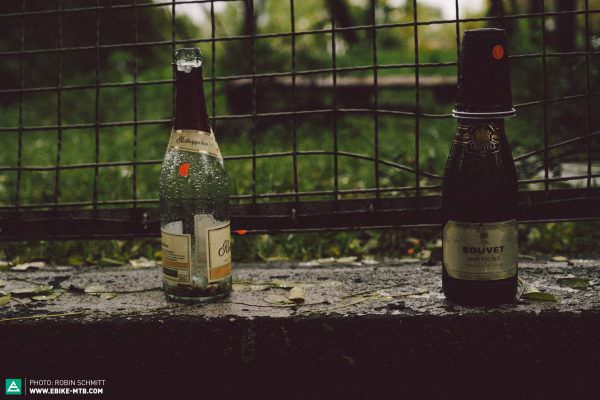


3/6 What’s going on? – How to spend time in Berlin
It’s a city where everyone is free to do their thing, whatever their thing might be. Art or pleasure, it’s the home harbour for everyone who goes against the tide. But how do you go about finding yourself in a city when you’ve only just got there? We chatted to six Berliners, each approaching the city in different ways.



Andres Ciccone (28)
Venezuela’s dictatorial political climate led Andres to flee his homeland and its system in 2015. He landed in Berlin, where his creativity has been able to flourish as he has found his feet as a freelancer amongst the excitement of the city. “I can be who I am here – and here I am,” explains the adopted-Berlin. In his work, he experiments with perspectives and explores the visual possibilities of movement within art.
andresciccone.squarespace.com | @andresciccone
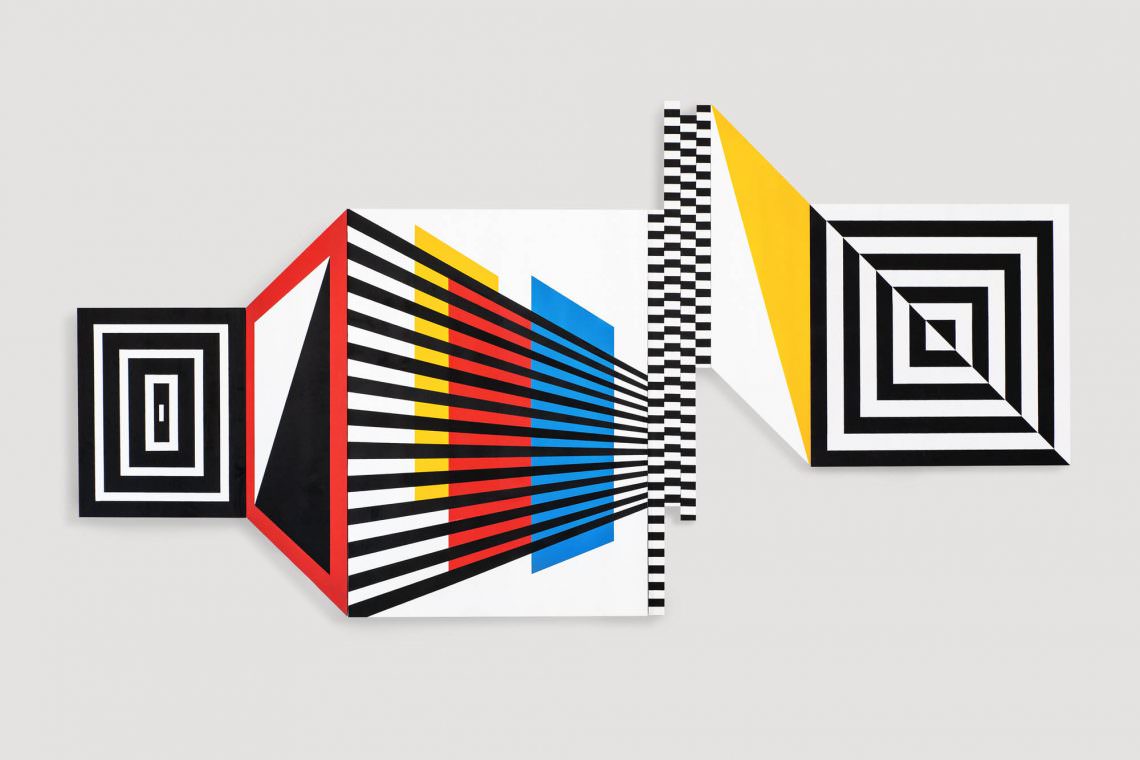
What’s a typical day for you?
I can often lock myself away for 16 hours or more in the studio on a given day. Then I’ll go for a run along the Spree, climbing with friends, or skating in one of Berlin’s many parks.
What do you usually do on the weekends?
Usually, I’ll meet friends for a beer somewhere in the evening. During the day we’ll check out new galleries, go for a bite to eat on the Paul-Lincke-Ufer, reminisce and dream about the future. When not doing that, I’ll probably still be in my studio, working on creating something from inspiration that I’ve picked up in the city. I find being in Berlin so stimulating.
Christian Wischnewski (36)
Christian has been living, working, cutting and pasting in Berlin since 2011. Originally from the Island of Usedom in Baltic Sea, he was drawn to the city by friends and family and has not left since. When not working as a freelance illustrator, the city inspires him to turn his hand to more creative art forms, seeing the sculptor repurpose items he finds on the pavement into an expression of his art. You might also spot him magnet-fishing in the Spree as a way of seeing what the city gives to him.

What’s a typical day for you?
Most of the working week is now spent at my home office, but I shouldn’t complain as I still regularly meet my friends outside and take walks through our ‘kiez’ with my girlfriend. Dining-wise, the best sorts of days end with Arabic food on Sonnenallee or at an Asian restaurant on Kantstrasse.
What do you usually do on the weekends?
Saturdays and Sundays are blocked out and dedicated to going deep into West Berlin’s flea market scene, lakes in East Berlin, or mushroom hunting in Brandenburg. Recently I’ve explored the historic wind tunnels in Berlin-Adlershof, scoped out disused railways in Neukölln and strolled around the heathland of the Döberitzer Heide. I’ll do like most Berliners and grab beers while out from a Späti, whichever local corner shop I pass.
Sophia Djacenko (25)
Having grown up in Prenzlauer Berg, Sophia has encountered Berlin’s many dimensions first-hand, learning to love them right from the start. Now older and wiser, she’s acutely aware of just how liberating the city is – a place not only for losing yourself but also finding your identity, free of judgements. After finishing school, she took a break from the city but failed to stay away for long, observing how the city has changed but still stayed the same in many ways. Her take on Berlin’s history? Fascinating, dynamic and devasting in so many ways.

What’s a typical day for you?
I’m currently doing a masters in ecology and environmental protection while working as a freelance translator, so I end up spending way more time in front of a screen than I’d like. On the occasions when I get outside in daylight, I enjoy going climbing or bouldering, and this pastime has let me discover a ton of amazing, new places. Evenings are best spent with friends and family before work demands my attention again.
What do you usually do on the weekends?
If I don’t have anything to prepare for university, I’d like to spend the day climbing. In the evening I’ll find a bar with live music and have a beer, maybe dance a little if I’ve got any energy. Sundays now follow a bit of a ritual: find a nice spot with friends to watch the world go by. You can lose yourself so easily creating stories for everyone that passes by. If we’re after an adventure, we might head out the city to Brandenburg, taking canoes out on the lakes and breathe some fresh air.
Nicole Michnewski (35)
Nicola landed in Berlin with a suitcase, her cat and her road bike in 2016. The reason: short on cash and her friend had a spare sofa. Her childhood was a mélange of two cultures, with food acting as the red thread. These days, Nicola runs Smakuje-Catering, whipping out meals for 600 wedding guests without a second thought, supplying cafes, and delivering to hungry office workers. Since 2020, her and her partner Petra Rimkus have been running Café EVE in the Samariterkiez but are currently limited to take-outs due to Covid restrictions. She’s a passionate baker and cook: “We produce almost everything right here, and the quality of our ingredients is super important – we’ll only use organic eggs, fair-trade organic sugar and organic flour.”
smakuje-catering.de | @evecoffeeandkitchen | Samariterstraße 29, 10247 Berlin

What’s a typical day for you?
Most of time I’m at our new Café EVE. After collecting fresh ingredients from the market each morning, you’ll find me in the kitchen cooking and baking lots of cakes – I think I’ve already baked more than 6,000! In the evening I’ll practice the accordion, play basketball or do some DIY; I’ve built most of our place myself. The kitchen still needs a bit of work. When you live in a city like Berlin, you need to carve out your own little bits of tranquility.
What do you usually do on the weekends?
In terms of food and culture, the city is unbeatable, plus we’re so close to all the forests that surround the city. Inline skating, open-water swimming in the lakes, collecting mushrooms in the woods, or just going for a glass of wine and food with friends – you can do all of these things in one day and that’s exactly why I love Berlin.
Malte Spindler (35)
If you’d asked Malte during his student days in Münster, where he planned to go next, he’d have said: ‘Anywhere but Berlin!’ His resolve didn’t last long and in 2011 the photographer moved to the capital with the reasoning that there were ‘more people, more opportunities, more art.’ Nowadays, his reason for being here is ‘Die Brueder’, The Brothers, a digital design agency and publishers. This network of editorial and web designers, journalists and photographers, illustrators, artists and programmers are responsible for a massive variety of projects, seeing everything through from concept to execution. Their motto: ‘The best things occur when you throw yourself into it.’ Their projects include events like the Indiecon Independent Publishing Festival and the Lucky Punch Press.
@lucky.punchpress | @indiemags

What’s a typical day for you??
Right now I’m usually in the studio in Friedrichshain, which is a cross between an office, atelier, printers and cabinet of curiosities. I work on things for my company, Die Brueder Publishing, as well as my own clients. If you asked my neighbours what my job is they would say: ‘He runs in a circle around the courtyard while on his phone, and sometimes builds strange things.’ When the courtyard gets too small, I take my camera out for a stroll around my neighbourhood. Berlin is changing so fast and there’s always something new to see, like what’s going on at RAW on Revaler Straße.
What do you usually do on the weekends?
On weekends I usually crank up the printing machine at the Lucky Punch Press so that various friends and artists can get their zines and prints printed. When not doing that I’ll go and explore somewhere new. Even after 10 years in Berlin, it never gets old. My current favourite is the Mäusebunker, ‘Mouse Bunker’ in Lichterfelde.
Aiko Göhler (30)
Aiko is an original Berliner. Brought up on two wheels, he managed to reach the pinnacle of mountain biking and was Germany’s first ever 4X World Champion – despite growing up in the flatlands of Berlin. He’s been shredding Berlin and its backyard for 15 years and can tell you about how rare it was to see a mountain biker in the woods back then. The scene is now booming and the 30-year-old pediatric physiotherapist wouldn’t live anywhere else. For Aiko, who can wax lyrical about the city’s greatness, Berlin ticks all the boxes.

What’s a typical day for you?
I try to ride a lap (or two) before I need to clock into work. I work until early evening as a physio for physically or emotionally less-able kids. I usually go bouldering after work, two or three times a week.
What do you usually do on the weekends?
On weekends you’ll usually find me in my shed doing woodwork, crafting small pieces of furniture or other things. When the weather is on my side and the forests are calling, I’ll take my enduro bike out for hot laps on the trails in and around Berlin.

4/6 Riding in Berlin – Where to go on two wheels
It’s easy to brush Berlin off as the preserve of fixies and Dutch bikes, but its nightlife isn’t the only scene where you can let off the brakes – very few people know Berlin just how many cool trails can be found in its proximity. Native Berliner Aiko Göhler, Germany’s first-ever World Champion in 4X took us out for airtime lessons on his home turf.
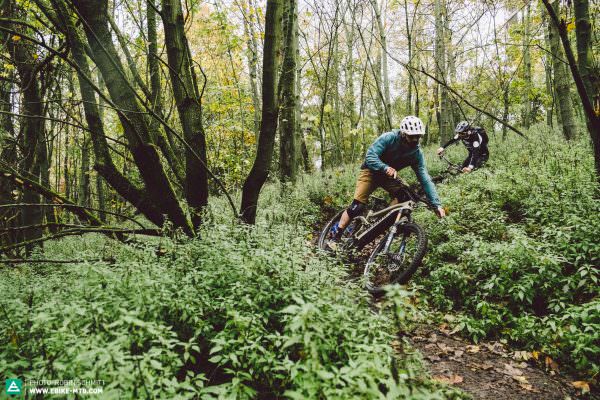


“Moin!” Aiko, clad in full riding gear enters our hotel, giving us a familiar greeting, reusable coffee cup in hand. It’s still early, with more grey clouds hanging over the city. Rush hour has barely got started. We’re heading westwards into Grunewald; it takes less than half an hour to reach the forest using tour mode on our eMTBs. This area was pancake flat until the end of the Second World War when it was repurposed as the dumping ground for 26 million cubic metres of rubble to form the 120 metre-high Teufelsberg – Devil’s Mountain. In 1972 topsoil and sand were added to the mound along with a million trees and it was put under a preservation order.




Under the autumnal Instagram-worthy hues of the trees, we find the uphill flow to the top. It’s hard to call it a summit when it’s so low, and the climb’s over before we know it. Fortunately, when climbs are that short, it lends itself to repeatability – over and over again. Each time we get to the top, the more our eyes adjust to the bizarre contours of the listening station built by the Americans in 1962 as part of their Cold War campaign. NATO used it for eavesdropping on the Warsaw Pact. It’s a mysterious place that’s so significant despite being so young in the grand scheme of history. The relic from another era, another world even, is now, somewhat strangely, a place to relax and sunbathe. The view from the dome of the abandoned listening station offers uninterrupted views over the forest and the nearby city.
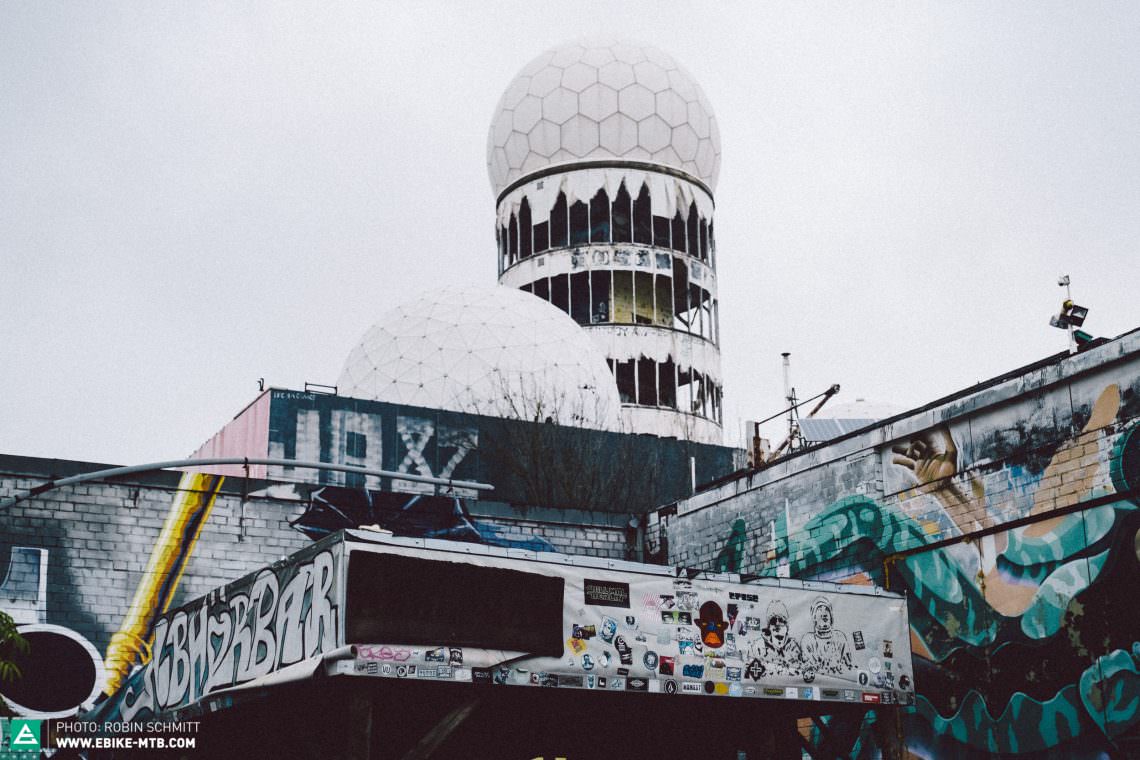


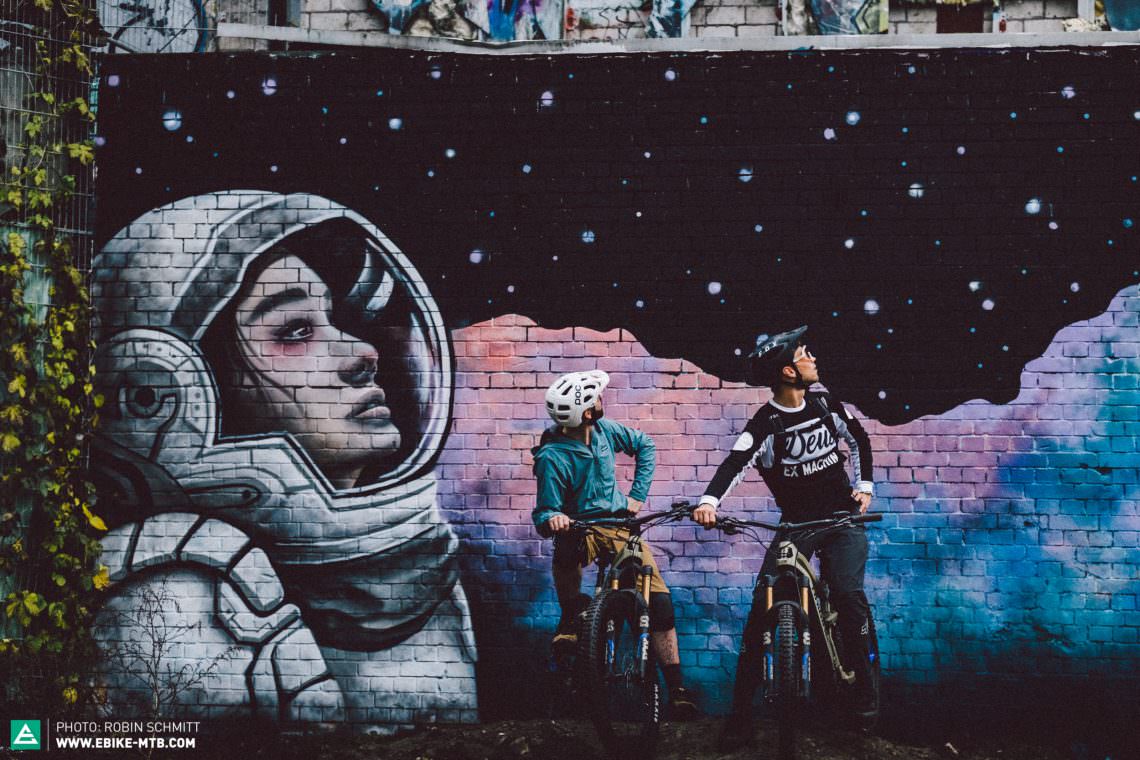
History dissected and digested, we’re back on the bikes. More downhills. There are six different ability manmade trails here, looked after by locals. They’re numbered rather than named. Six is the one that hooks us most, and given the shortness of each trail, we hot-lap it, over and over. Depending on the trail, you’re looking at around 1–2 minutes for each descent, then 5 minutes back up with the eMTB. It’s easy to rack up distance on the trails of this artificial berg. When we’re up for the final time, we pause to check out the view again. Would we bring bikes on our next visit? Hell, yes.



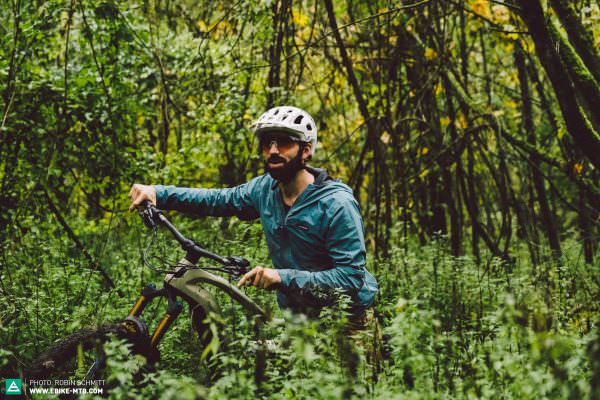


Back into town along the East-West axis following the 45 metre-wide Straße des 17. Juni, a memorial to the 39 victims that died in the uprising in the German Democratic Republic as they protested against the regime. The city’s dark past catches up with you sometimes when you least expect it. We ride by one of Germany’s most important national monuments – the Siegessäule, the Victory Column also known as the ‘Goldelse’. Next up is the Brandenburg Gate, where Viktoria, the goddess of victory with her chariot harnessed to four horses is on the top, brings peace back to the city. We take a final photo. That’s enough for today, back to the hotel.


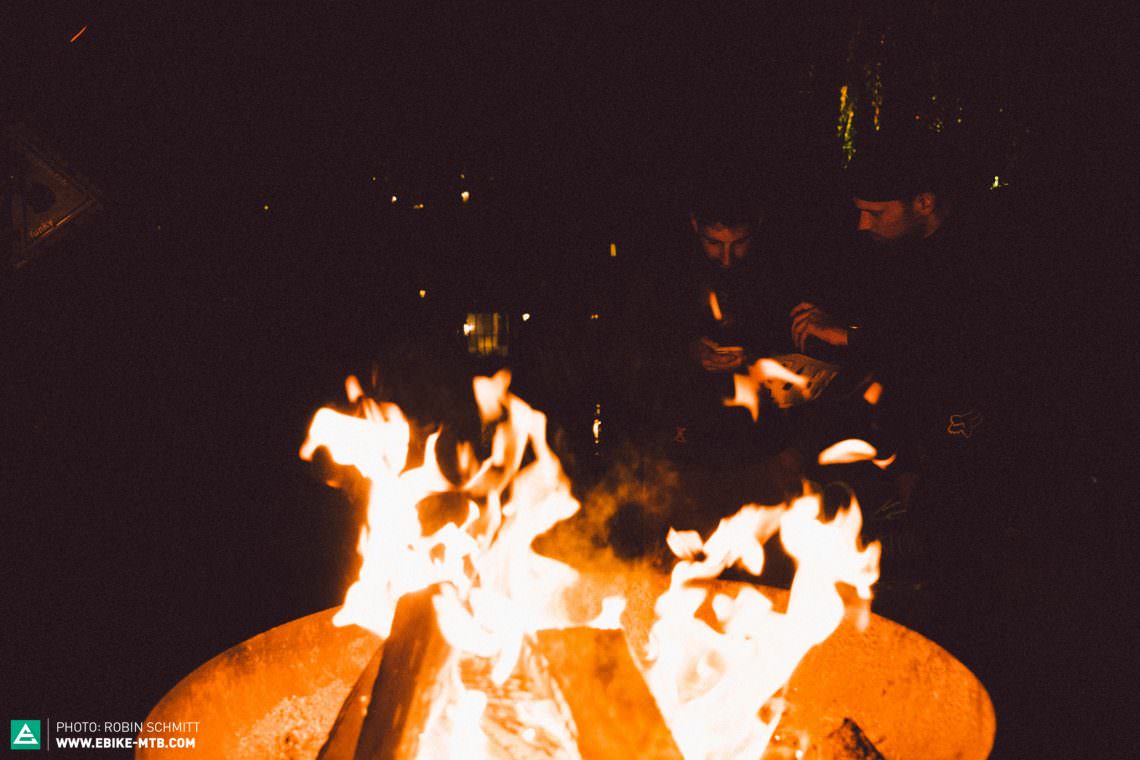
Berlin fires your imagination with routes in every single direction. With almost half of its territory untouched – we’re talking forests, river, parks – it bags the title of Germany’s greenest city. Eight times bigger than Paris with just a fifth of the population, there’s room to play: head north for lush, verdant forests with lakes and moorland, go west to the Teufelsberg for more manicured, well-looked-after trails, south of the city is where you’ll find the farmland, while in the east you’ve got the Müggelberge and official bike park trails.

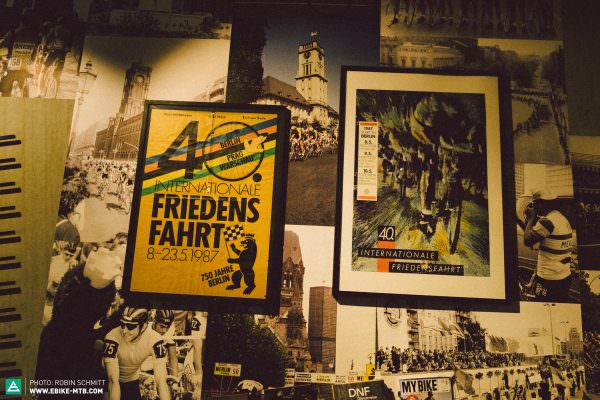
5/6 Escape Essentials – Cafés, bars, restaurants, dos and don’ts in Berlin
Bike Shops and rental
Standert
For lovers of all things two-wheeled, admire everything from fixies and sit-up-and-begs to road bikes.
Cool beers, trendy cafe.
Invalidenstraße 157, 10115 Berlin-Mitte | standert.de
Rapha
Roadies rejoice; head here for events, workshops, group rides, coffee and cake.
Alte Schönhauser Str. 5, 10119 Berlin | rapha.cc
Das Radhaus
With 8 locations across the city, here’s where to get your bike fixed.
das-radhaus.de
Fahrrad.de Berlin
The physical store of fahrrad.de with a wide selection and workshop for servicing.
Augsburger Straße 36, 10789 Berlin | fahrrad.de



Hotels
Provocateur
Glamour, decadence, playfulness: a distinctive hotel that channels the charm of the 1920s. Excellent restaurant, good bar for a glass of wine, of take a bottle of fizzy stuff to your room, where the headboard is a mirror and red velvet wins. Don’t come here expecting an early night.
Brandenburgische Str. 2, 10707 Berlin | provocateur-hotel.com
25hours Hotel Bikini Berlin
Lions and giraffes meet big city hitters in the heart of Berlin’s listed centre. The lobby with its reception, hammocks, kiosk and in-house bakery reflects the raw, unpolished charm of the city’s creative scene. Go to the 10th floor for a beer in the evening and look out over the lights of the Kurfürstendamm and the zoo. Start or finish your night here – it all goes, we’re in Berlin!
Budapester Straße 40, 10787 Berlin | 25hours-hotels.com
i31 Hotel
Boutique hotel near central station, where, amongst other lodging options, you can sleep in renovated containers on the city’s rooftops.
Invalidenstraße 31, 10115 Berlin | hotel-i31.de
Michelberger
Hip hotel with a love for detail, top breakfast and barrel sauna in the courtyard. Located in the heart of East Berlin’s nightlife area, not far from Berghain and the East Side Gallery.
Warschauer Str. 39–40, 10243 Berlin | michelbergerhotel.com




Cuisine – Dinner
A clash of gourmet and world cuisine, Berlin knows exactly how to tickle your taste buds. Try and find a nationality that isn’t represented on a plate. Berlin has to rank amongst the top kebab places in the world purely based on sheer density. But for the occasions when a döner or falafel won’t cut it, try these:
Kopps
Multiple award-winning fine dining vegan restaurant with innovative and tasty dishes.
Linienstraße 94, 10115 Berlin | kopps-berlin.de
Con Tho
Fusing traditional Vietnamese cuisine with locally sourced ingredients, Con Tho is one of our must-eats.
Hasenheide 16, 10967 Berlin | con-tho-restaurant.de
heimlichTreu
Tucked away, bring your friends and family here for first-rate food, great wines and a cosy atmosphere.
Anklamer Str. 38 (2. Innenhof), 10115 Berlin | heimlichtreu.de
Burgeramt
According to Burgeramt, taste can account for up to three-quarters of love and the remaining quarter is based on your passion for hip-hop. Burgeramt is known for its beats, bars and burgers.
Krossener Str. 21–22, 10245 Berlin | burgeramt.com
Beirut der 70er
Intimate Lebanese restaurant on Boxhagener Platz. Pay cash, tuck in, and don’t forget the peanut sauce!
Grünberger Str. 84, 10245 Berlin | beirut-der-70er.de

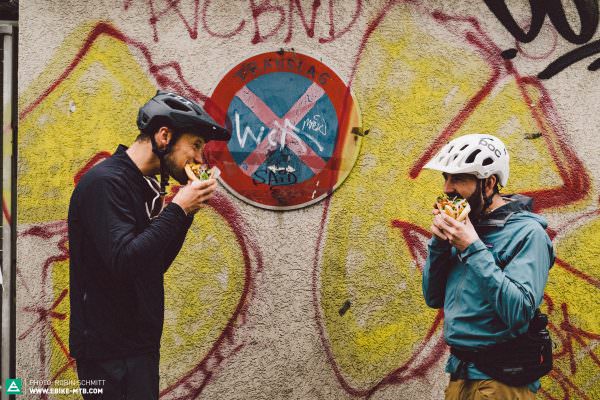

Cuisine – Coffee and cake
Café im Literaturhaus
Looking for somewhere to chill out for the afternoon? Head to the sophisticated Literaturhaus and enjoy the birdsong as you relax in the cafe and engross yourself in a book.
Fasanenstraße 23, 10719 Berlin | cafe-im-literaturhaus.de
EVE coffee&kitchen
EVE is the place to go for amazing coffee, great cakes, quiches, stews and much, much more. The open kitchen hatch lets you gape at the cook and baker in action.
Samariterstr. 29, 10247 Berlin | @evecoffeeandkitchen

Cuisine – Bars
Schwarze Traube
A daily changing drinks menu isn’t the only appealing aspect of this welcoming award-winning bar.
Wrangelstraße 24, 10997 Berlin | schwarzetraube.eatbu.com
Hotel am Steinplatz
There’s nothing run of the mill about this deserving winner of ‘Hotel Bar of the Year’, with super cool bartenders, first-rate drinks and everything basked in a golden light.
Steinplatz 4, 10623 Berlin | hotelsteinplatz.com
Basalt
As green as botanical garden, this bar has serves up everything a cocktail lover loves. Smokers can even retire to the aquarium.
Utrechter Straße 38, 13347 Berlin | @basalt_berlin
Herr Lindemann
Cocktails with healing powers? This bar whips up uniquely curative creations using wellness-boosting herbs.
Richardplatz 16, 12055 Berlin | @herrlindemannbar


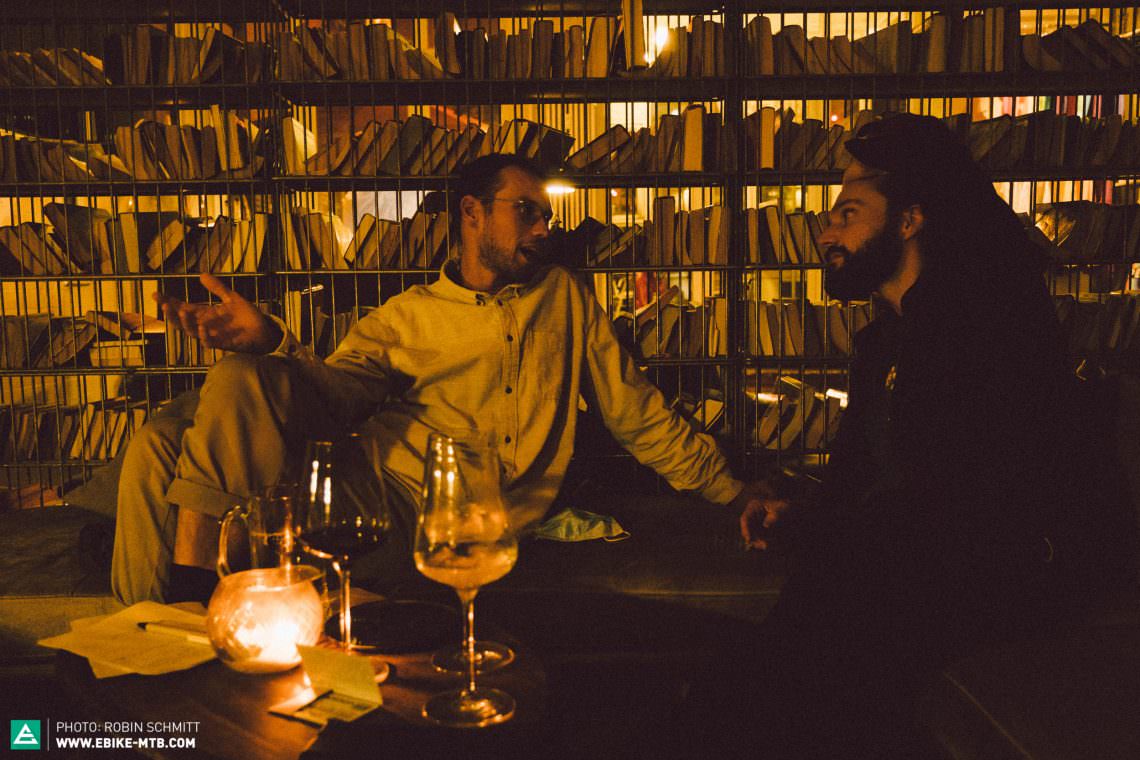
Dos
- BBQ in one of the many parks
- Make the most of the sun when it’s out
- Party past sunrise
- Pay cash
- Find a vintage photo booth
- Eat a veggie döner kebab
- Immerse yourself in the coffee culture
- Go to flea markets
- Explore the listening station on the Teufelsberg
- Enjoy the view from the top of the Teufelsberg
- Get beer from a Späti corner shop
- Eat every sort of cusine going
- Cross the Oberbaumbrücke


Dont’s
- Pay by card
- Fall into stereotypes
- Forget genders
- Walk in the bike lanes
- Leave valuables in your car
- Leave your bike unlocked
- Lock a bike outside without a GPS tracker on it
- Speak English in the queue for Berghain
- Wear high heels to a club
- Throw away beer bottles or cans
- Try to ride public transport for free
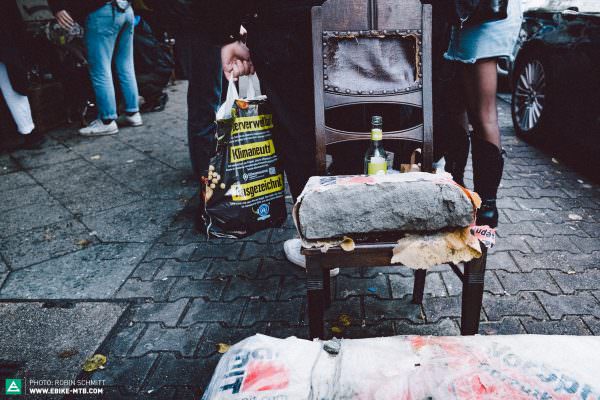


Berlinerisch for beginners
Pronounciation differences between Berlinerisch and High German are noticeable, with the classic German ‘ch’ turning into a harsher, flatter ‘k’ while a hard ‘g’ in German softens to a ‘j’. When it comes to grammar, they’ve adopted an almost equally as relaxed approach here as they have to their lifestyle.
- Schrippe – bread roll
- Pinte – bar
- Molle – glass of beer
- ekal – whatever, either
- icke – I/me
- dit – this/that
- Wat? – what?
- Wa? – Come again?
- een, eene, eener – 1, ein, eine, einer
- keen, keene, keener – 0, kein, keine, keiner
- uff – on
- nüscht – nothing, nichts
- Atze, Keule – friend
- kieken – to look (informal)
- koofen, eenkoofen – to shop
- loofen – to run
- Pulle – bottle
- Quanten – feet
- Mauken – smelly feet
- Flosse – hand
- Muckefuck – bad coffee
- Muffe – heart
- Muffensausen – fear
- uffmucken – cause trouble, snap back at
- Flitzpiepe – a person you don’t take seriously
- Fatzke – an arrogant person
- Husche – rain showers that come and go in an instant
- verfatzen – to disappear
- meschugge – crazy
- Fisimatenten – cause trouble, dodge


6/6 Escape faster – Our electric bikes in Detail
Haibike XDURO AllMtn 10.0
The Haibike XDURO AllMtn 10.0 is the sharpest knife in Haibike’s cupboard. With the FLYON motor and its 120 Nm, you’ll be first over the line when the traffic lights turn green. Rest assured; you’ll have a good view of the large FLYON display so this will ensure that you won’t inadvertently use up all your ponies without realizing it. It displays motor power and current battery life of the 630 Wh battery at al times. The integrated lights are a welcome asset when your nighttime meanderings come to a reluctant end. When you swap the urban sprawl for Berlin’s backcountry, the DT Swiss suspension on the XDURO AllMtn provides ample travel with 180 mm equipping you for the burliest trails around.





Haibike AllMtn 7

You would be hard pressed to find a better option for a City Escape than a Haibike AllMtn 7. The strong-as-a-bear Yamaha PW X2 motor won’t be caught by anyone or anything, so whether you’re fleeing the daily grind in the capital, topping up your fresh air exposure along the River Spree, or venturing into the forests to shred, this € 6,199 Haibike rig is an absolute steal. With a 600 Wh battery, super capable off-road spec and modern geometry teaming with a stylish full carbon frame and 160 mm of first-class FOX Factory suspension, this cuts a fine figure in the city, the backcountry, or the trails.



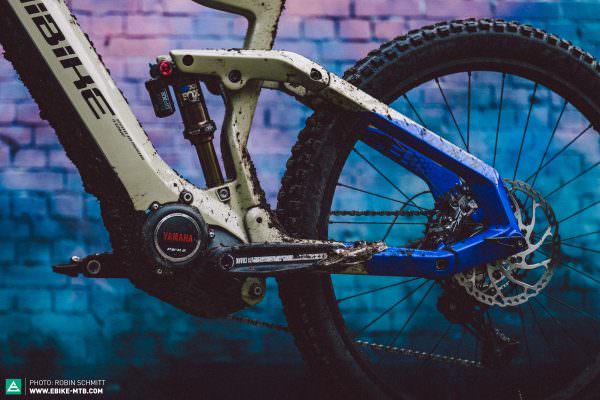
Did you enjoy this article? If so, we would be stoked if you decide to support us with a monthly contribution. By becoming a supporter of E-MOUNTAINBIKE, you will help secure a sustainable future for high-quality cycling journalism. Click here to learn more.
Words: Julian Lemme Photos: Robin Schmitt






